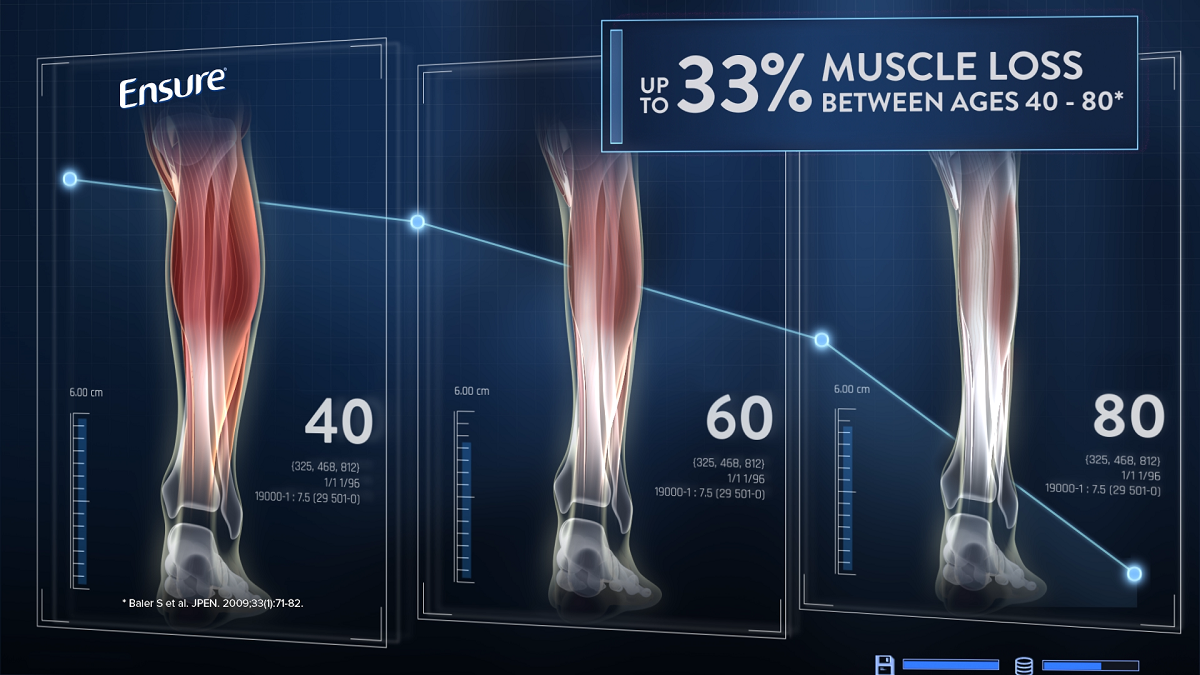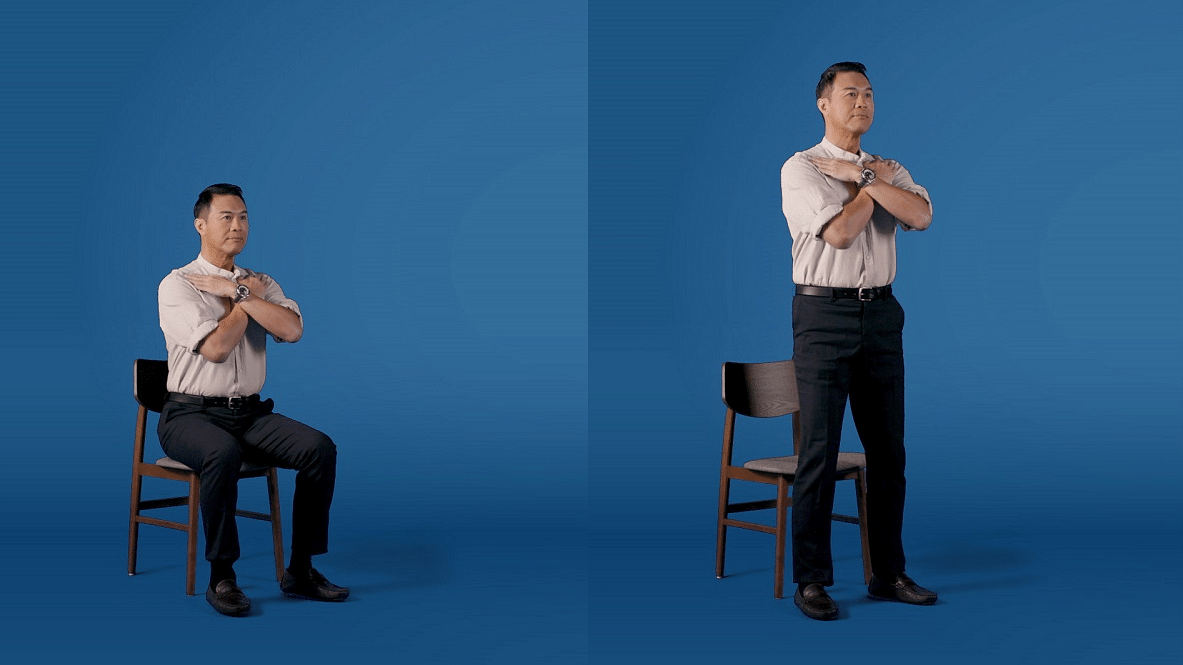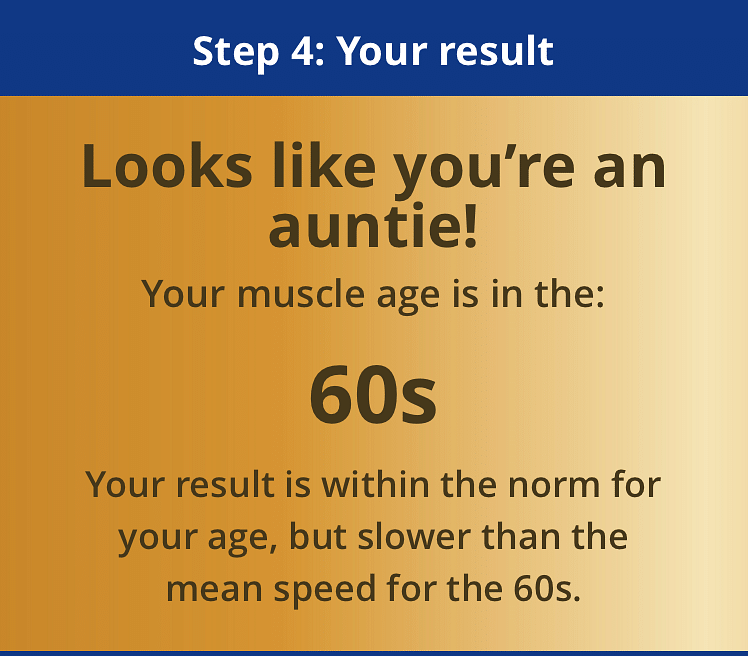BRANDED CONTENT
What you need to know about your muscle age after 40
Loss of muscle mass and strength as you age can put you at higher risk of immobility, more frequent falls and make daily activities such as climbing the stairs difficult

Adults aged 40 years and above face a higher risk as they start to lose up to 8 per cent of muscle mass every decade. PHOTO: ABBOTT
Audrina Gan
Follow topic:
When I was in my mid-30s, I experienced knee pain after walking down a slope at my neighbourhood park. This was followed by bouts of pain and tightness behind the joints of my knee after running on the treadmill. I consulted a doctor and he advised me to do alternative cardio exercise such as cycling to reduce the strain on my joints and muscles. A couple of my friends in a similar age group have also reported similar problems with their lower limbs.
Contrary to popular belief that only elderly people will experience loss of muscle, adults aged 40 years and above also face a higher risk as they start to lose up to 8 per cent of muscle mass every decade. The rate of muscle loss can almost double after the age of 70. A sedentary lifestyle and an unbalanced diet will also significantly increase the rate of muscle mass loss.
According to the American Journal of Clinical Nutrition, Volume 84, Issue 3, December 2006, muscle mass can impact a person's strength, energy, mobility, and overall health. Hence, the threat of a notable increase in age-related diseases such as sarcopenia, which is the progressive loss of skeletal muscle mass and strength and function is real, as we grapple with a rapidly ageing population. By 2050, one in six people in the world will be over age 65 (16 per cent), up from one in 11 in 2019 (9 per cent), according to data from World Population Prospects: the 2019 Revision.
Sarcopenia could lead to physical disability, low quality of life, loss of independence, or even death. As muscle loss progresses, older people may begin to reduce their physical activities, leading to further loss of muscle strength and endurance. These will significantly increase the risks of fall and fractures.
Sarcopenia could also lead to slower recovery from illnesses, leading to increased length of hospital stay and frailty. It can also cause a decline in the resting metabolic rate, which increases the risk of Type 2 diabetes and dyslipidemia. Dyslipidemia, refers to one or more kinds of unhealthy lipid (fat) in your blood such as triglycerides or low-density lipoprotein (LDL).
Essentially, muscle mass, strength, and metabolic function are necessary for us to be able to exercise and carry out the activities of everyday life.
Signs of muscle loss
One of the simplest ways to assess muscle strength in older adults is to assess their handgrip. If you've struggled with opening a jar whose lid wouldn't budge, that's an indication that your hands are getting weaker. Other signs of muscle loss include less energy and fatigue, slower walking speed, unintentional weight loss and frequent falls.
To be sure, muscle loss is more common than you might think. Phase 1 of a two-part study, called Strengthening Health in Elderly through Nutrition, was conducted by Changi General Hospital, SingHealth Polyclinics, and Abbott amongst 400 healthy people aged 65 and older in Singapore. It found that despite their apparent health, one in five were at risk of low muscle mass. Women fared worse, with 25 per cent of them having low muscle mass compared to 15.5 per cent of men. With the fast ageing population in Singapore, sarcopenia and its impact on quality of life is an increasingly important health issue. According to an article in Healthxchange.sg, our lower limbs experience a greater loss of muscle mass and function, compared with the upper limbs. The result is that it becomes more difficult for the elderly to perform simple everyday tasks, such as climbing the stairs, lifting objects and even getting up from a chair. ""As muscle loss progresses, older people may reduce their physical activities which, in turn, can lead to their being more and more deconditioned (loss of muscle tone and endurance)," said Adj A/Professor Melvin Chua, the Society for Geriatric Medicine Singapore and Sengkang General Hospital.
Test your muscle age

To help us estimate our muscle age, global healthcare company Abbott has devised a simple tool, the Muscle Age Calculator, as part of its #Stand4Strength Challenge (see textbox). One simply needs to sit-to-stand on both legs five times with arms folded as fast as possible to discover muscle age, which refers to the indication of muscles' strength and performance in the lower limbs. Use a timer to time yourself doing the #Stand4Strength challenge, enter the time into the calculator and you will have the results based on your age and gender.
I did the test and my 8.2 second timing indicated that I'm an auntie with a muscle age of someone in her 60s even though I'm 43 this year. While the result is within the norm for my age group, it is still slower than the mean speed for the 60s age group, which mean I need to ramp up on strengthening my muscles.

Why muscles matter
So why is it important to keep our muscles strong? When we lose muscle mass, we face a higher risk of immobility, increased falls, loss of independence, and physical and mental fatigue. "Muscle strength is one of the key indicators of our overall health and as muscle mass declines, you may face a higher risk of disability and even loss of independence. Hence it is important for us to start taking active steps to build muscle strength," says Adj A/ Professor Chua.
Moreover, building up your muscles also strengthens your bones and tendons, preventing broken bones and tendon sprains and tears. Many athletes use muscle training to help them improve their athletic performance and reduce injuries. If you've ever struggled to move a storage box, you will understand how strong muscles can help you to carry out everyday activities with minimal effort.
Aim for exercise and proper nutrition
While we can't reverse the natural ageing process, we can minimise or slow down the process of muscle loss with exercise and complete & balanced nutrition. The first step is to choose the right foods that can help our bodies maintain or rebuild muscle. Avoid processed, sugary foods and focus on having a balanced diet of lean proteins, vegetables, fresh fruits, whole grains, legumes, and healthy fats.
As many of us may know, protein is the building block of healthy muscles. Unfortunately, low calorie and low protein diets can become more common as we age due to changes in our sense of taste and poor oral health (e.g. less teeth or poorly fitted dentures or problem with swallowing).
Aim to have a source of high protein at each main meal. Good sources of protein include meat, shellfish, eggs, yoghurt, nuts, and beans. As we age, it also becomes harder for our bodies to absorb protein. That means the amount of protein our bodies need changes. To combat muscle loss, older adults need nearly 50 per cent more protein than younger adults, and even more as they succumb to illness. "When you're older, your body isn't able to utilise protein as well as it did when it was younger," explains Ms Abby Sauer, a registered dietitian at Abbott. The recommendation is to consume 1.2g of protein for every 1kg of body weight, which translates to 72g of protein for someone weighing 60kg.
Vitamin D also plays a crucial role in muscle health as it helps in supporting bone and muscle strength and bone density. Take an outdoor walk and opt for oily fish such as salmon and mackerel, eggs, and fortified breakfast cereals to boost your Vitamin D intake.
For those who cannot achieve a well-balanced diet each day, The World Health Organization recommends taking a complete, balanced Oral Nutrition Supplement (ONS) to improve muscle mass and strength, supporting mobility and vitality.
Immobility due to prolonged illness and periods of decreased activity also increase the rate of muscle loss. If a muscle is not used, the body will eventually break it down to conserve energy. Thus, regular exercise is also an effective way to increase muscle mass and strength.
If your job requires you to sit a lot, remember the "sit for 60, move for 3" rule. Stand up and stretch or walk around the office for at least three minutes for every hour you sit. The Centres for Disease Control and Prevention also recommends that adults should participate in strength training exercises at least two days a week along with aerobic exercise for maximum health benefits and to maintain their muscle mass. Examples of strength training include lifting weights, using resistance bands, and doing push-ups, pull-ups, and sit-ups.
Protect yourself from muscle loss
Sarcopenia, if left undetected, can lead to higher risks of bone fractures arising from falls, increased mortality, functional decline in everyday activities and physical disability. Now that you know the risks of losing muscle mass, you can protect yourself from progressive muscle loss by exercising regularly and following a healthy diet. Consider taking an oral nutrition supplement to improve overall muscle strength. Good nutrition and a diet rich in protein will allow you to preserve muscle mass and strength to continue doing your favourite activities even as you age. To find out more about your muscle age, visit abbottfamily.com.sg/brands/ensure/stand4strength-muscle-age-calculator to join the #Stand4Strength Challenge.
How to do #Stand4Strength Challenge
Step 1:
Choose a suitable chair. The height of the chair should be approximately 43cm.
Step 2:
Use a timer to time yourself doing the Stand4Strength challenge. Sit-to-stand on both legs five times with arms folded as fast as you can.
Step 3:
Enter your details in the muscle age calculator.
Enter your details in the muscle age calculator.
This educational initiative is brought to you by Ensure® Life from Abbott.

